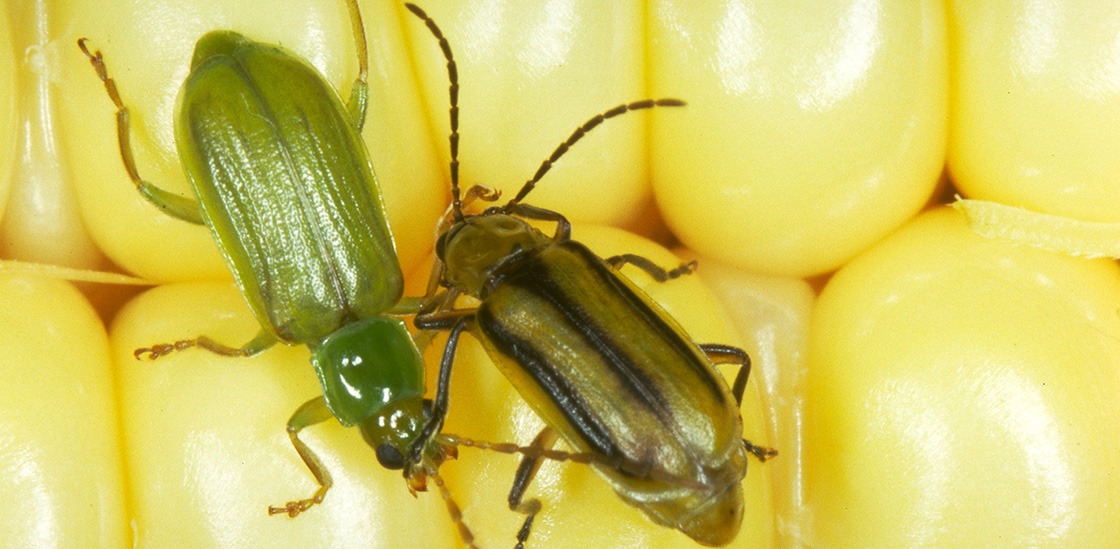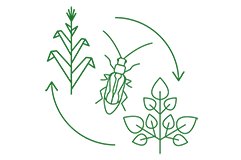Soil Bound LLC | 570-380-3153
Soil Bound LLC | 570-380-3153
Pioneer agronomists and researchers dig up the truth on common CRW myths.

Of all the pests that threaten corn yields, none have the seemingly infinite capability to adapt and overcome management strategies that corn rootworm (CRW) has displayed. These adaptations are how CRW continues to cause over a billion dollars in damage yearly across the US.

Rootworms’ ability to evolve has made crop rotation ineffective in many areas. The soybean variant western corn rootworm has evolved to lay eggs in non-corn fields. The northern corn rootworm has shown extended diapause, in which eggs remain viable in the soil for several years before hatching.

Plants with damaged root systems are more susceptible to drought stress and lodging, meaning rootworm damage is a gateway to a host of additional yield threats.

Rootworm larvae AND adults cause severe problems, which means potential issues all season long. Adult CRW feeding on corn silks during pollination can cause poor seed set and subsequent yield loss.

Resistant corn rootworm populations have now been documented for all four commercially available Bt proteins for CRW control.
No solution is foolproof, and CRW will surprise you. Root digs and sticky traps can determine rootworm pressure (when done right) and help you make the best decision.
Root digs for larvae scouting will help in-season to determine if a response is needed. Sticky traps can be used to estimate adult CRW populations, a crucial warning for next year’s populations.
CRW pressure varies field-to-field and can significantly vary within a field.
Scouting should begin in early to mid-June or when corn is between V6 to V12. Dig up 2 plants at each of 5 locations within the soil from 6” to 8" around the plant and sift soil over a sheet of black plastic, looking for 1/32” to ½” long larvae.
Corteva research digs tens of thousands of roots every year in the most challenging CRW environments we can find to test how the industry’s traits are holding up.
Sticky traps are good for field-to-field observations and will help you make a better-informed decision on next seasons management options. But don’t use sticky traps for hybrid-to-hybrid population comparisons as CRW can move up to a ½ mile radius and come from another location.
Unfortunately, only limited CRW trait technologies exist, and many seed brands use the same ones. While the latest addition, new RNAi technology is exciting, it’s not a standalone solution to the full problem.
Many seed brands use the same CRW traits. Simply switching brands does not necessarily mean switching to different Bt traits.
More on Corn Insect Protection
The bigger difference from seed brands comes from the genetics of the hybrids, like yield potential, root strength or disease tolerance.
The RNAi trait can take up to 12 days to kill CRW, a window in which large amounts of feeding damage can still occur. Stacking RNAi technology with other CRW traits that act immediately, including Bt traits with the Cry34/35 protein, helps eliminate this gap.
An integrated approach to CRW management will always be the most successful. These include industry best practices like crop rotation, suppressing larval development, insecticides and more.
No! With limited traits to combat CRW, it’s important to not lose sight of the advantages from powerful agronomic traits and excellent yield potential. There’s no need to sacrifice hybrid performance for CRW protection, you can have both.
CRW traits are important for root health on high pressure CRW acres, but they’re not the full story. High yield potential and strong agronomic traits like native root strength and disease tolerance play critical roles in overall plant health.
Pioneer® brand Qrome® products have averaged a 6-8 bu/A yield advantage* over competitive products with SmartStax® technology for the last three years.
Pioneer® brand Qrome® products contain a different version/event of the Bt protein Cry 34/35 compared to other products in the industry (SmartStax, AMXT).
This version has opened up a wider germplasm funnel for our breedings, leading to more product options with key agronomic traits and CRW trait protection.

*Data is based on the average of comparisons made in the US 2019-2021. Comparisons are against all competitors, technology segment matched, unless otherwise stated, and within a +/- 3 CRM of the competitive brand. Efficacy from multiple trials with moderate & high CRW pressure at 8 locations in 2014, 6 locations in 2015, 8 locations in 2016, 8 locations in 2017, 10 locations in 2018, 9 locations in 2019, and 15 locations in 2020.